On the Position of /s/ in Slovak Consonant Clusters: an Acoustic and Perceptual Analysis
on

e-Journal of Linguistics
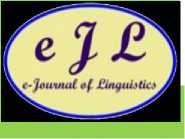
Available online at https://ojs.unud.ac.id/index.php/eol/index
Vol. 17, No. 2, July 2023, pages: 241--252
Print ISSN: 2541-5514 Online ISSN: 2442-7586
https://doi.org/10.24843/e-jl.2023.v17.i02.p13
On the Position of /s/ in Slovak Consonant Clusters: an Acoustic and Perceptual Analysis
1Renáta Gregová
Pavol Jozef Šafárik University, Košice, Slovakia, renata.gregova@upjs.sk
2Eva Kiktová
Pavol Jozef Šafárik University, Košice, Slovakia, eva.kiktova@upjs.sk
|
Article info |
Abstract* |
|
Received Date:5 May 2023 Accepted Date: 31 Juni 2023 Published Date: 31 July 2023 Keywords:* Slovak, consonant clusters, sonority violation, acoustic analysis, perception |
The paper presents the results of research aimed at the acoustic and perceptual analysis of onset and coda clusters from standard Slovak that violate the principle of sonority. The research is based on Engstrand and Ericsdotter’s (1999) claim that clusters violating sonority are perceptually advantageous over those that follow the sonority principle. The analysis was carried out on a sample of test nonsense words with the initial combinations /sp, st, sk/ and final combinations /ps, ts, ks/. The data were produced and evaluated by native Slovak language speakers. The results of the research support the assumption about the perceptual advantage of clusters that are not in accordance with sonority. |
The fundamental notion in syllable theory is sonority. It is the relative loudness of a sound, its “carrying power” (Jones, 1969, p. 24), made by the function of vocal cords and the opening of cavities during articulation (see, e.g., Ladefoged, 1992)1. As a consequence, vowels as the “tones of free cavities” (Ondruš & Sabol, 1987, p. 81) are believed to be the most sonorous sounds, representing the top of the so-called sonority hierarchy, and voiceless stops as the category of consonants, that is, “noises at the place of an obstacle” (Ondruš & Sabol, 1987, p. 81), are the less sonorous sounds and form the bottom of this hierarchy (for details on the sonority hierarchy, see, e.g., Parker, 2012). One of the most famous theories of the syllable, the so-called sonority theory says that the centre of the syllable is the most sonorous sound and the sonority of the other segments in the syllable decreases towards the syllable margins (Jespersen, 1904). Nevertheless, as it is well-known, in languages, there are consonant clusters occurring in onset or coda positions that violate this principle of sonority in the syllable structure and are still considered very frequent in the given language. For example, DeLisi (2015), in an analysis of the syllable structure of ancient Indo-European languages (Sanskrit, Latin and Greek), shows that this violation of the arrangement of consonants in the initial (and also in the medial) position of the syllable is caused predominantly by the fricative /s/. Similar findings are reported by research into English. The English three-consonant clusters occurring in the initial position have the structure ‘consonant s–stop–constrictive’, for example, /str, spr/ (see, e.g., Giegerich, 1992; Gregová, 2012). The special position of the consonant /s/ in the syllable structure is known in
Italian (DeLisi, 2015), Icelandic (Engstrand & Ericsdotter, 1999), Bella Coola and Georgian (Cho & King, 2003). Consonant clusters starting with the fricative /s/, and also other consonant sequences that violate the principle of sonority, can be found in Russian in combinations nasal + obstruent (mzda), liquid + obstruent (rvať) and liquid + nasal (lnúť) (O’Brian, 2006). In Polish, there are combinations sonorant + obstruent + sonorant or two-consonant clusters with liquids and nasals (rtec, mchu) (Pawelec, 2012), and similar sequences of consonants are reported in Czech (Ziková, 2017), Slovak (Gregová, 2021), etc.
Obviously, the literature on the given topic is rich; however, details about consonant clusters not adhering to the sonority principle in the syllable structure are varied. For some authors, the inter-language violation of sonority is represented by the alveolar consonants (especially by the consonant -s-) only. These consonants “behave exceptionally in a number of ways, and have to be excluded from various generalizations, though it is not yet quite clear why” (McMahon, 2002, p. 109). Other authors consider the exceptional behaviour of the consonant -sin the initial position of words (syllables) as a feature typical of the English language only (Cho & King, 2003). And for a third group of linguists, the violation of sonority (mainly by sibilants) in the syllable structure is a typological feature (Ziková, 2017). Moreover, as the literature survey indicates, authors dealing with the violation of sonority in the syllable structure offer various explanations for the existence of consonant clusters in languages that do not obey sonority and yet are very common. For example, Gouskova (2002) gives a set of phonological rules formally describing the existence of the exceptions to the principle of sonority. Giegerich (1992), Pawelec (2012) and others call consonants violating sonority ‘extrasyllabic’. Cho and King (2003) speak of so-called ‘semisyllables’. Ziková (2017) indicates historical and morphological reasons for the existence of so-called ‘ill-formed consonant clusters’, that is, those that do not adhere to the principle of sonority, and Engstrand and Ericsdotter (1999) introduced the idea of the possible perceptual advantage of the consonant clusters that violate sonority over those that follow it. This assumption is based on a research probe that was carried out on a sample of test nonsense words uttered by one native speaker of Icelandic. The recordings were then acoustically analyzed and perceptually evaluated by ten listeners with various language backgrounds. The details of this research, which turned out to be very inspiring to us, are presented in the following subsection.
The research has its roots in the thought that onset clusters like [sp], [st] and [sk] and coda clusters with the reverse order of segments, that is, [ps], [ts], and [ks], “have a perceptual advantage over those predicted by the sonority hierarchy” (Engstrand & Ericsdotter, 1999, p. 49). This idea results from the premise that listeners can reliably identify the stop place of articulation solely on the basis of the adjacent [s] because the stop place of articulation is present before and after the given stop consonant, that is, both in [s] and in a vowel (Engstrand & Ericsdotter, 1999). This hypothesis was verified by research. As indicated above, the authors performed an experiment founded on the acoustic and perceptual analysis of the audio recordings of six nonsense words: [spaj], [staj], [skaj], [japs], [jats] and [jaks]. The acoustic analysis aimed at a detailed investigation of broadband spectrograms proved that the acoustic spectrum of the fricative [s] is influenced by the place of articulation of the neighbouring stop. As for the perceptual analysis, the listeners were able to identify the place of articulation of the stop consonant by dint of the acoustic information incorporated in the nearby [s]. The authors thus came to the conclusion that “[…] the commonly encountered initial [s]+stop and final stop+[s] clusters […] may have a perceptual basis” (Engstrand & Ericsdotter, 1999, p. 49 – 52).
The initial consonant clusters starting with /s/ and the final sequences of consonants ending with /s/ are also quite common in standard Slovak (see below), though they violate the principle of sonority. We will now briefly introduce the structure of the Slovak syllable and the sequences of consonants that do not correspond to the sonority principle.
The maximum phonological structure of the Slovak syllable is CCCCVVCCC2. The centre of the syllable can be a short monophthong (V), a long monophthong (VV) or a diphthong (VV) (for details, see, e.g., Gregová, 2016). As for the initial consonant clusters, 93.9% of them are binary (CC), three-consonant clusters represent 5.8% of all onset clusters, and four-consonant clusters (CCCC) have the lowest frequency of occurrence with only 0.3% (Sabol & Ivančová, 2014; see also Gregová, 2021). The situation in the coda position is similar: two-consonant clusters are dominant with 91.4% of occurrences, and three-consonant clusters represent 8.6% out of all final clusters in Slovak (Gregová, 2021).
There are 34 various types3 of initial (onset) CC clusters in Slovak4. Seven types of those clusters are not in accordance with the sonority principle. Three-consonant initial clusters fall into 28 categories, with 16 types of clusters violating the sonority principle. As for the initial CCCC clusters, they can be divided into five different types, and four of them do not follow the principle of sonority (Gregová, 2021). All types of the initial two-, three- and four-consonant clusters that violate the sonority principle with the sample clusters and the sample words with the given clusters can be found in Table 1.
Table 1
The Slovak initial consonant clusters that do not obey the principle of sonority
|
structure of the cluster violating the sonority principle |
sample cluster(s) |
sample word(s) | |
|
CC clusters |
voiceless fricative + voiceless stop |
sp, st, sk |
spať ‘to sleep’, stoh ‘stack’, skaziť ‘to spoil’ |
|
voiceless fricative + voiced fricative |
sv, xv |
svetlo ‘light’, chvost /xvost/5 ‘tail’ | |
|
voiced fricative + voiced stop |
vd, vď /vɟ/6 |
vdova ‘widow’, vďaka /vɟaka/ ‘thanks’ | |
|
liquid + voiceless stop |
lk |
lkať ‘to lament’ | |
|
liquid + voiced fricative |
lž /lʒ/ |
lživo /lʒivo/ ‘falsly’ | |
|
voiceless affricate + voiceless stop |
cť /tsc/ |
ctený /tsceni:/ ‘honoured’ | |
|
CCC clusters |
nasal + voiced stop + liquid |
mdl |
mdlý ‘insipid’ |
|
nasal + voiceless fricative + voiceless stop |
msť /msc/ |
mstiť sa /mscic sa/ ‘to revenge’ | |
|
voiced fricative + voiced fricative + voiced stop |
vzd |
vzduch /vzdux/ ‘air’ | |
|
voiced fricative + voiced stop + liquid |
zbl |
zblízka ‘from near’ | |
|
voiced fricative + voiced stop + voiced fricative |
zdv |
zdvih ‘lift’ | |
|
voiced fricative + voiced stop + sonorant |
zgň /zgɲ/ |
zgniaviť /zgɲiavic/ ‘to get sb. down’ |
|
voiced fricative + voiced stop + nasal zdn zdnu ‘from the inside’ voiceless fricative + voiceless fricative + voiceless stop s vsa fsac o ge up voiceless fricative + voiceless affricate + voiced 7 fricative scv scvrknutý shrunk voiceless fricative + voiced fricative + liquid svr svrab ‘scabies’ voiceless fricative + voiceless stop + liquid str struna ‘string’ voiceless fricative + voiceless stop + sonorant fpľ /fpʎ/ vpletať /fpʎetac/ ‘to wreathe’ voiceless fricative + voiceless stop + voiced fricative v ʃv va ʃvac c ase stmievať sa /stmievac sa/ voiceless fricative + voiceless stop + nasal stm voiced fricative + nasal + sonorant hmľ /hmʎ/ hmlisto /hmʎisto/ ‘hazily’ sonorant + voiceless fricative + voiceless stop ľsť /ʎsc/ ľstivo /ʎscivo/ ‘tricky’ | |
|
CCCC clusters |
voiceless stop + voiceless fricative + voiceless stop + liquid pstr pstruh trout voiced fricative + voiced fricative + voiced stop vzdmúť sa /vzdmu:c sa/ ‘to + nasal vzdm hoist’ voiceless fricative + voiceless fricative + voiceless stop + liquid fspr vzpružiť /fspruʒic/ to energize voiceless fricative + voiceless fricative + voiceless stop + voiced fricative s v vz v a fs v ac o ower |
The phonotactic possibilities of the final (coda) clusters in Slovak are rather poor compared to the onset position. The final CC clusters can be divided into 19 types and only two types violate the principle of sonority. These are the clusters with the structure
-
(1) voiceless stop + voiceless fricative, for example the cluster ‘ps’ in the word čľups /ʧʎups/ ‘plop’, or the cluster ‘ks’ that can be found in the word keks ‘biscuit’;
-
(2) sonorant + nasal, for example the cluster ‘jn’ in the word kombajn ‘harvester’ (Gregová, 2021).
Three-consonant clusters occurring in final position are of three types only, and all of them follow the sonority principle (for details, see Gregová, 2021).
The data from Slovak, similarly to other languages (see above), show that – contrary to the idea of sonority as the leading power in the syllable structure – the order of sounds in syllables (words) also obeys some other rules and principles. Although the occurrence of most of the clusters that are not in accordance with the principle of sonority (Table 1) is restricted to onomatopoetic expressions and foreign words (Gregová, 2021), initial clusters starting with the fricative /s/ are the most common clusters in contemporary standard Slovak (Gregová, 2021). Analogically, for the final position, the most common sequences of consonants are the mirror images of the initial sequences with the fricative /s/, that is, the sequences ‘stop + fricative’. To find the answer to the question of why clusters not in accordance with sonority are so frequent in languages, in the following part of the paper, we will present the acoustic and perceptual analysis of the consonant sequences starting/finishing with the fricative /s/ in line with the theory of
Engstrand and Ericsdotter (1999) claiming that the initial sequence ‘fricative + stop’ and its mirror image in the final position is perceptually advantageous to the one predicted by the sonority hierarchy. The results of our research will help prove or disprove the cited theory.
In the first stage of our research, we used the same test nonsense words as were presented by Engstrand and Ericsdotter (1999), that is, the words [spaj], [staj] and [skaj] for the initial consonant sequences and the words [japs], [jats] and [jaks] for the final consonant sequences. These words serve for an analysis of the initial sequences /sp, st, sk/ and the final sequences /ps, ts, ks/8. The other consonant clusters violating sonority that occur either in the onset (see Table 1) or the coda position (see the section Initial and final clusters in Slovak and the principle of sonority) will be analyzed later, in the next stage of our research, depending on the results of the present preliminary investigation. Since the aim of our research is to test the hypothesis about the perceptual advantage of consonant clusters starting with the fricative sound [s] in Slovak, the speakers pronouncing the nonsense words for recordings were native Slovak language speakers, and the respondents involved in the perceptual investigation of the recordings were native Slovak language speakers too. We thus also take into account the close relationship between the acoustic and articulatory aspect of speech production. In particular, the so-called articulatory basis – the system of articulatory stereotypes typical of speakers of the given language (Dvončová, 1980, p. 73) – may be different in different language(s), and it has its reflection also in the acoustic properties of produced speech sounds and their subsequent perception.
-
3.1 Method of the analysis
The experimental research presented in this paper was carried out in the LICOLAB (Laboratory of Experimental Phonetics and Communication), Faculty of Arts, Pavol Jozef Šafárik University in Košice, Slovakia. Two native speakers of Slovak (one female and one male) were recorded in the studio by a Rode NT 2000 microphone in the mono channel mode, * .wav file format with a resolution of 16 bits per sample and a sampling frequency of 44.1 kHz. Each speaker produced each word five times. All in all, we gained ten recordings of each nonsense word. Spectrograms in a range up to 22 kHz were created and inspected for all recordings. This analysis was done in Praat (Boersma, 2001). Sample oscillograms and spectrograms for both voices are presented below in Figure 1 for [spaj], [staj] and [skaj] and in Figure 2 for [japs], [jats] and [jaks].
For measuring the ability to perceive the stop place of articulation of /p, t, k/ on the basis of an adjacent fricative consonant /s/, 15 personal computers (Win 10, 64-bit, Intel Core i7 – 7700 CPU, 16 GB RAM) with external sound cards (Creative Sound Blaster X-Fi HD) and closed AKG K77 headphones were used. All tests were running through the university e-learning portal (lms.upjs.sk).
As for the perceptual analysis, 50 native Slovak language speakers (all university students aged between 20–25 years) were played the recordings of the initial sequences /sp, st, sk/ and their mirror images /ps, ts, ks/ segmented from the full forms of the test nonsense words. The respondents were asked to listen to the initial segments from the beginning of the recording up to the cursor position (Figure 1), and for mirror images, they listened to segments from the cursor position up to the end of the entire sound file (Figure 2).
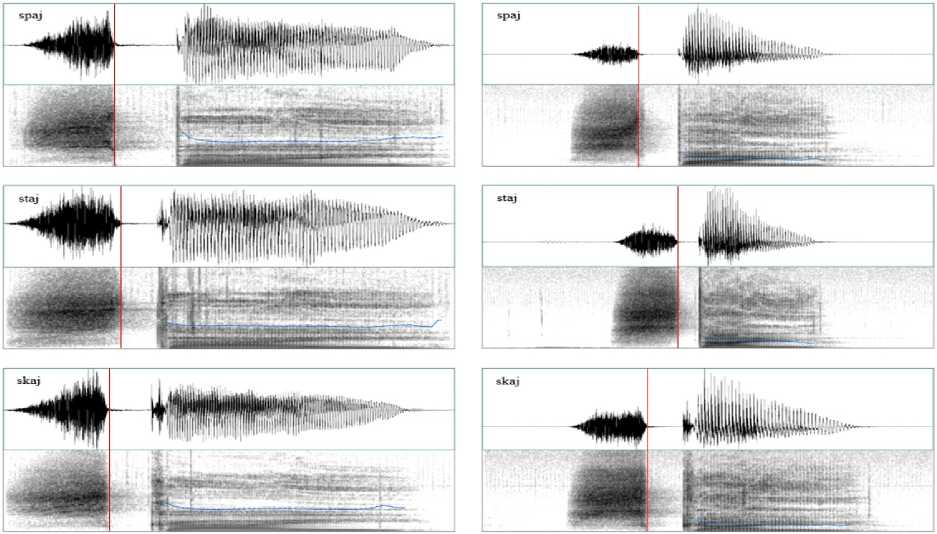
Figure 1. Oscillograms (top) and spectrograms (bottom) for onset position (left – female voice;
right – male voice)

Figure 2. Oscillograms (top) and spectrograms (bottom) for coda position (left – female voice; right – male voice)
There were two perceptual tests, one with five recordings of each consonant sequence produced by the female voice (thus 15 initials + 15 finals) and the second also with five recordings of each consonant sequence uttered by the male voice (15 initials + 15 finals). In sum,
there were ten recordings for all consonant sequences, that is, 60 recordings altogether. The respondents were asked to determine from which word – [spaj], [staj] or [skaj] for the initial clusters and [japs], [jats] or [jaks] for the final clusters – the sound [s] was segmented out. It was possible to play each recording several times, if necessary. The results of the acoustic analysis and perceptual tests are summarized below. They were carried out in laboratory conditions.
The results of acoustic and perceptual analysis are presented in this section.
In the spectrograms (Figure 1 and Figure 2), the cursor position marks the segment– spectral slice used in the analysis of its spectral content. The spectral slices of the analyzed nonsense words for the initial clusters [spaj], [staj] and [skaj] and final clusters [japs], [jats] and [jaks] were averaged. Thus, five spectral slices (8 – 10 ms) were averaged to one. The results for the female voice are captured in Figure 3.
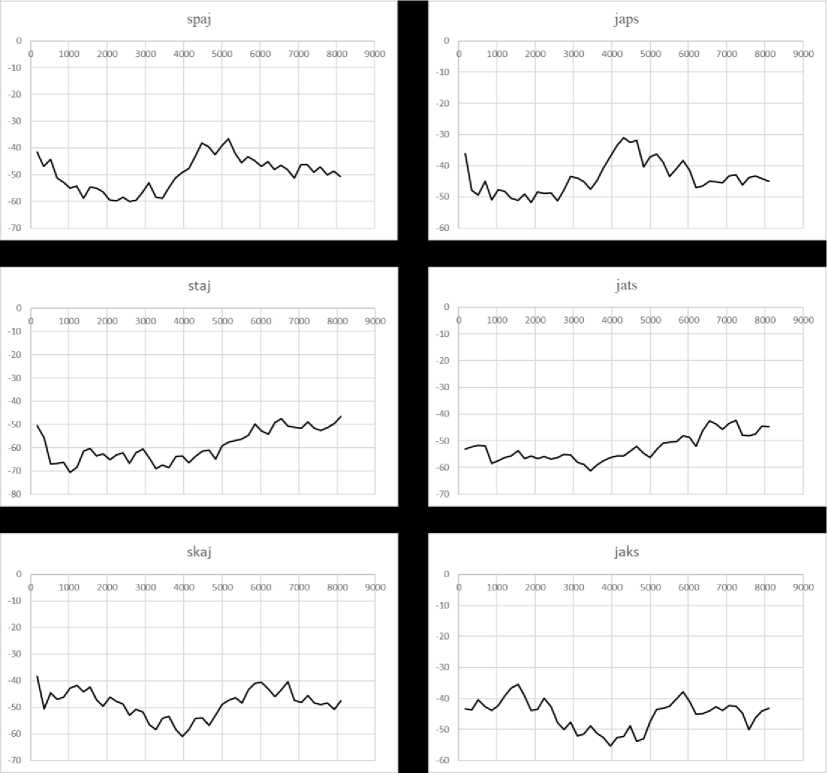
Figure 3. The averaged spectral slices (x-axis – amplitude [dB], y-axis – frequency [Hz])
The difference between the spectral distribution for the analyzed spectral slices of initial sequences /sp, st, sk/ and final combinations /ps, ts, ks/ is obvious. A similar spectral distribution can be observed between the initial combinations and their final mirror images /sp – ps/, /st – ts/ and /sk – ks/. The same findings are also valid for the male voice.
Perception tests were carried out separately for the female and male voice. Fifty participants were involved in the tests. At the beginning of the testing process, a test demonstration was carried out. Although the test environment was well known to the participants, they still had the option of a short training test. Thus, we do not assume that the results of the presented tests should be influenced by ignorance of the test routine. The listener could listen to the sound fraction repeatedly and match the perceived sound to the original word. Finished tests were automatically evaluated, overall four tests, in each test 15 sounds.
The probabilities of the correct recognition of the initial and final sequences are presented in Table 2. Male voice stimuli achieved higher recognition rates than female ones, except for the final sequence /ts/.
Table 2
Results of perceptual tests
|
Probability |
Initial sequence |
Final sequence | ||||
|
spaj |
staj |
skaj |
japs |
jats |
jaks | |
|
female |
0.792 |
0.624 |
0.484 |
0.592 |
0.788 |
0.692 |
|
male |
0.834 |
0.698 |
0.804 |
0.772 |
0.716 |
0.844 |
The overall results of the perceptual tests with averaged results for the initial and final consonant combinations under investigation are presented in Figure 4. Recognition rates reached up to 70% for both the initial and final sequences. Nevertheless, it is important to note that no pre-processing of the yielded test data was done, i.e, all reached results were accepted and processed. Thus, this presented research also reflects the fact that not everyone can distinguish such a soft sound difference. Some participants achieved very low scores, but this was accepted as a normal state.
|
ONSET | |||
|
100% |
77.87% | ||
|
80% |
63.33% |
70.60% | |
|
60% |
♦44444 | ||
|
444444 | |||
|
444444 | |||
|
40% |
♦♦♦♦♦♦ | ||
|
♦♦♦♦♦♦ | |||
|
20% | |||
|
♦♦♦♦♦♦ | |||
|
0% |
I-I-LJ-LJ- | ||
|
Ofemale |
□ male |
□ female +male | |
|
CODA | ||
|
100% | ||
|
80% |
77.73% 69.13% |
73.43% |
|
60% |
¾ ------ |
+++♦+4 |
|
4⅛4⅛44 | ||
|
♦♦♦♦♦* | ||
|
40% |
♦44444 | |
|
444444 | ||
|
444444 | ||
|
20% |
444444 | |
|
444444 | ||
|
0% |
j ∣444444∣ | |
|
Sfemale (Dmale |
≡ female + male | |
Figure 4. Summary of the results for initial (onset) and final (coda) sequences
Except of the descriptive statistics for achieved data presented in Table 3, a different perspective on the achieved results can be found in Figure 5. Violin plots show summary results for onset and coda position for both male and female voices. Violin plots depict the full distribution of the data with presence of different peaks and in this case, they show the distribution of scores achieved in four tests, the mean and median for each of them.
Table 3
Descriptive statistics of data
|
Initial sequence |
Final sequence | |||
|
female |
male |
female |
male | |
|
Mean |
9.5 |
11.68 |
10.37 |
11.66 |
|
Median |
10.5 |
13 |
11 |
12 |
|
Standard deviation |
3.20 |
3.84 |
2.97 |
2.37 |
|
Minimum |
1 |
0 |
5 |
5 |
|
Maximum |
15 |
15 |
15 |
15 |
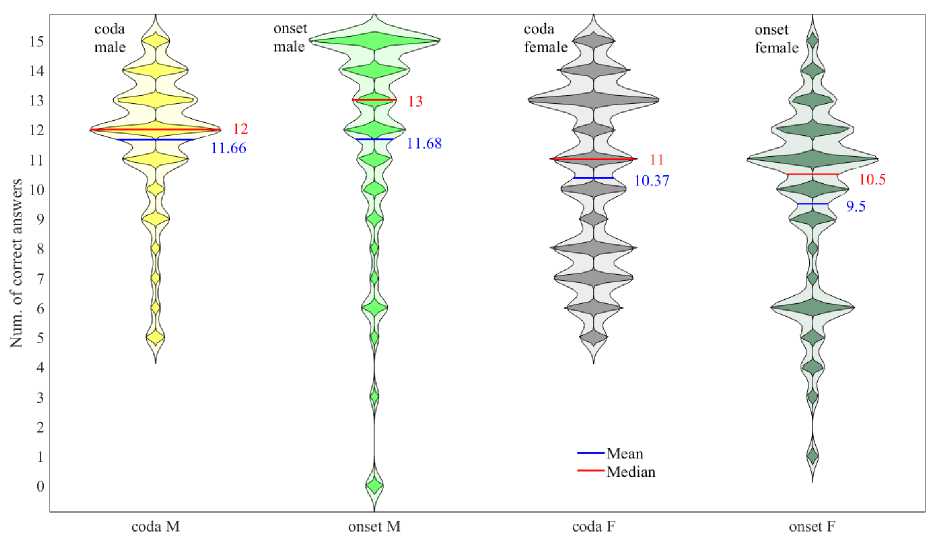
Figure 5. Violin graph of distribution of achieved scores in each perceptual test
The histogram in Figure 6 depicts the frequency of data occurrence for the partial test with the lowest average recognition rate 63.33% that belongs to female onset test (Figure 4). In this case, it reflects the total number of participants and their yielded score in this test. Six participants achieved a score of five or lower than five correct answers, and 31 participants achieved a score of ten or more correct answers.

Figure 1. Histogram for one test (female voice, onset) with the lowest recognition rate of 63.33% (the x axis – number of correct answers; the y axes – number of participants)
The paper introduces the first perceptual and acoustic analysis of the consonant clusters in Slovak that are not in accordance with the principle of sonority. The results of this pilot study indicate the perceptual advantage of the initial consonant clusters /sp, st, sk/ and the final clusters /ps, ts, ks/ over the clusters following the sonority principle.
The sonority theory of the syllable (Jespersen, 1904) explains the organization of segments in this unit on the basis of their sonority. Nevertheless, in languages, there are common clusters occurring either in onset or in coda positions that violate the principle of sonority. Various authors have offered various explanations on how to account for this phenomenon. Engstrand and Ericsdotter (1999) assume that the existence of clusters breaking sonority may have a perceptual basis. Their research probe indicates the verity of this assumption. This paper has presented the results of similar research aimed at the analysis of data from Slovak. In the Slovak language, as well as in other languages, the principle of sonority is not obeyed in particular by the fricative consonant -s-. However, the inventory of the Slovak initial consonant clusters that are not in accordance with the sonority is more numerous (Table 1). In the first stage of the research, we concentrated on the clusters starting with -s- and their final mirror images.
Based on the perceptual tests performed, it can be concluded that in the cases of the initial consonant clusters /sp, st, sk/ and the final clusters /ps, ts, ks/, the listeners were able to perceive the stop place of articulation on the basis of an adjacent fricative consonant /s/, as previously indicated by the research probe of Engstrand and Ericsdotter (1999). The experimental amplitude-frequency analysis of spectral slices confirmed the results of the perceptual tests. Our research, carried out on test nonsense words produced and then evaluated in perception tests by native Slovak speakers, supports the idea of the perceptual advantage of either word-(syllable-)initial or word-(syllable-)final consonant clusters that violate the sonority principle. The research thus indicates that sonority is one power, but not the only one, governing the creation of consonant clusters when creating words. Of course, in the next stage of the research, it will also be necessary to analyse the other types of Slovak consonant sequences that do not follow the principle of sonority. Only thorough analyses of all the data will prove or disprove the claim about the perceptual benefit of clusters violating sonority.
This work was supported by the Scientific Grant Agency of the Ministry of Education, Science, Research and Sport of the Slovak Republic and the Slovak Academy of Sciences under the research project VEGA 1/0344/21.
References
Boersma, P. (2001). Praat, a system for doing phonetics by computer. Glot International, 5(9/10), 341-345.
Cho, Y. Y., & King, T. H. (2003). Semisyllables and universal syllabification. In C. Féry & R. van de Vijver (eds.), The syllable in optimality theory (pp. 183-212). Cambridge University Press.
DeLisi, J. (2015). Sonority sequencing violations and prosodic structure in Latin and other Indo
European Languages. Indo-European Linguistics, 3, 1-23.
Dvončová, J. (1980). Fyziologická fonetika. Slovenské pedagogické nakladateľstvo.
Engstrand, O., & Ericsdotter, Ch. (1999). Explaining a violation of the sonority hierarchy: stop place perception in adjacent [s]. In Proceedings from the XII Swedish Phonetics Conference (pp. 49-52). Göteborg University, Department of Linguistics.
Giegerich, H. J. (1992). English phonology. An introduction. Edinburgh University Press.
Gouskova, M. (2002). Exceptions to sonority distance generalizations. In R. Singh & S. Neuvel
(eds.), CLS 38: The main session. Papers from the 38th meeting of the Chicago Linguistic Society (pp. 253-268). CLS.
Gregová, R. (2012). Sonority-based analysis vs. complex-sound analysis of the word-initial consonant clusters in English and in Slovak. Ostrava Journal of English Philology, 5(2), 7-23.
Gregová, R. (2016). The generative and the structuralist approach to the syllable: a comparative analysis of English and Slovak. Cambridge Scholars Publishing.
Gregová, R. (2021). The Sonority Sequencing Principle and the structure of Slovak consonant clusters. Studia z Filologii Polskiej i Słowiańskiej, 56, Article 2341.
https://doi.org/10.11649/sfps.2341
Jespersen, O. (1904). Phonetische grundfragen. Teubner.
Jones, D. (1969). An outline of English phonetics. Cambridge University Press.
Kuryłowicz, J. (1948). Contribution à la thèorie de la syllable. Biuletyn Polskiego towarzystwa językoznawczego, 8, 80-114.
Ladefoged, P. (1992). A course in phonetics. Harcourt Brace Jovanovich.
McMahon, A. (2002). An introduction to English phonology. Oxford University Press.
O’Brian, J. (2006). Sonority sequencing, phonological scales, and Russian word edges.
jeremypobrein.nfshost.com. Retrieved October 28, 2019.
Ondruš, Š., & Sabol, J. (1987). Úvod do štúdia jazykov. Slovenské pedagogické nakladateľstvo.
Parker, S. (2012). Sonority distance vs. sonority dispersion – a typological survey. In S. Parker
(ed.), The sonority controversy, 101-166. Walter de Gruyter.
Parker, S. (2018). Sonority. Oxford Bibliographies Online. https://doi.org/10.1093/OBO /9780199772810-0042
Pawelec, P. (2012). The sonority sequencing generalization and the structure of consonant clusters with trapped sonorants in Polish. Anglica Wratisaviensia, 50, 183-195.
Sabol, J., & Ivančová, L. (2014). Slabičné rozhrania v modeloch trojčlenných konsonantických skupín v slovenčine. Jazykovedný časopis, 65(2), 105-121.
Zec, D. (2007). The syllable. In P. de Lacy (Ed.), A Cambridge handbook of phonology. Cambridge University Press. https://doi.org/10.1017/CBO9780511486371.009, 161–194.
Ziková, M. (2017). Sonorita. In P. Karlík, M. Nekula, & J. Pleskalová (eds.), CzechEncy - Nový encyklopedický slovník češtiny. https://www.czechency.org/slovnik/SONORITA
Biography of Authors
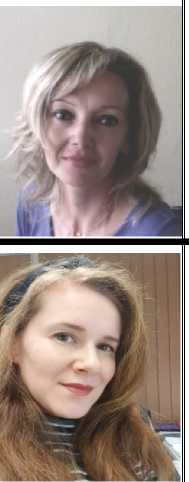
Renáta Gregová is an associate professor at the Pavol Jozef Šafárik University in Košice, Slovakia. Her research interest is in the field of phonetics, phonology, morphophonology, but also language universals and typology. She is the author and the co-author of several research papers and textbooks. She has also published two books: Quantity in Slovak and in British English (2012) and The Generative and the Structuralist Approach to the Syllable. A comparative analysis of English and Slovak (2016).
Email: renata.gregova@upjs.sk
ORCID ID 0000-0003-4743-2559
Eva Kiktová is an assistant professor at Pavol Jozef Šafárik University in Košice, Slovakia.
Email: eva.kiktova@upjs.sk
ORCID ID 0000-0001-9325-7339
-
1 For the phonemic delimitation of the notion of sonority, see, for example, Zec 2007 or Parker 2018.
-
2 C stands for consonant, V stands for vowel.
-
3 An (almost) complete list of all tokens of initial, medial and final clusters obtained from a thorough analysis of several sources and the Slovak national corpus can be found in Gregová, 2012 and Gregová, 2016.
-
4 The analysis of consonant clusters in Slovak was based on Kuryłowicz’s well-known idea that the beginning of the word represents the beginning of the first syllable of the word and that the end of the word is simultaneously the end of the final syllable of the word (Kuryłowicz, 1948).
-
5 If the sound form of the word is different from its graphic form, slashed brackets are used.
-
6 If a grapheme differs from a transcription symbol used for the representation of a given sound, the sound form is noted down with the IPA symbol.
-
7 Although /r/ is a consonant phonetically, it functions as a vowel here. The syllable structure of the given word is CCCV.CCV.CV.
-
8 Recall here that the initial clusters /sp, st, sk/ and the final clusters /ps, ts, ks/ are the most frequent consonant clusters in contemporary standard Slovak (section Initial and final clusters in Slovak and the principle of sonority).
Discussion and feedback